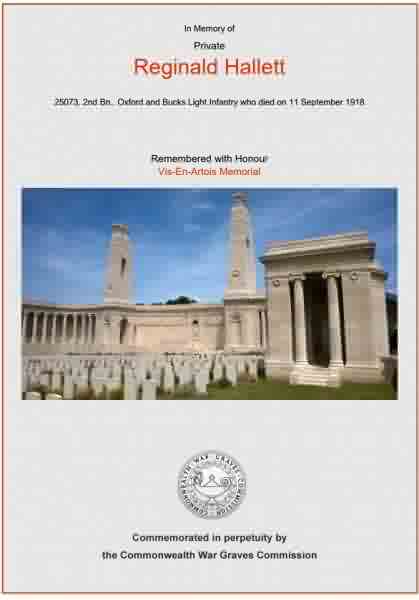yeovil at War
Reginald Hallett
Killed in action during day-to-day trench warfare
Reginald Hallett was born in Yeovil in 1890, but we have no further information on his family or early life. It is assumed that his family moved to Wiltshire when he was quite young and the only reference to him is in the 1911 census when he was a boarder at 2 Water Side, Downton, Wiltshire. At this time 21-year old Reginald gave his occupation as a tailor.
 Although
we don't know
when, it is
known that
Reginald
enlisted at
Swindon,
Wiltshire,
giving his
address as
Weston-super-Mare,
Somerset. He
initially
enlisted in the
Wiltshire
Regiment with
the Service
Number 11571.
Although
we don't know
when, it is
known that
Reginald
enlisted at
Swindon,
Wiltshire,
giving his
address as
Weston-super-Mare,
Somerset. He
initially
enlisted in the
Wiltshire
Regiment with
the Service
Number 11571.
At some point Reginald was transferred to the 2nd Battalion, Oxford & Bucks Light Infantry. His new Service Number 25073 suggests this took place in early 1917.
The 2nd Battalion took part in the Arras Offensive. This was a major British offensive and, from 9 April to 16 May 1917, troops from the four corners of the British Empire attacked trenches held by the army of Imperial Germany to the east of the French city of Arras.
As part of the Arras Offensive the 2nd Battalion, probably including Reginald, took an active part in the First Battle of the Scarpe (9 to 14 April 1917) that was part of the overall Arras Offensive.
Zero-Hour for the First Battle of the Scarpe had originally been planned for the morning of 8 April (Easter Sunday) but it was postponed 24 hours at the request of the French, despite reasonably good weather in the assault sector. Zero-Day was rescheduled for 9 April with Zero-Hour at 05:30. The assault was preceded by a hurricane bombardment lasting five minutes, following a relatively quiet night. When the time came, it was snowing heavily; Allied troops advancing across no man's land were hindered by large drifts. It was still dark and visibility on the battlefield was very poor. A westerly wind was at the Allied soldiers' backs blowing "a squall of sleet and snow into the faces of the Germans". The combination of the unusual bombardment and poor visibility meant many German troops were caught unawares and taken prisoner, still half-dressed, clambering out of the deep dug-outs of the first two lines of trenches. Others were captured without their boots, trying to escape but stuck in the knee-deep mud of the communication trenches. Most of the British objectives had been achieved by the evening of 10 April.
After just a couple of weeks of relative calm the 2nd Battalion, including Reginald, were involved in the Second Battle of the Scarpe (23-24 April 1917). At 04:45 on 23 April, following two days of poor visibility and freezing weather, British troops of the Third Army attacked to the east along a nine mile (14 km) front from Croisilles to Gavrelle on both sides of the Scarpe. On the left of the main British attack the 63rd Division made rapid progress against Gavrelle and secured the village. Several determined German counter-attacks were made and by the morning of 24 April, the British held Guémappe, Gavrelle and the high ground overlooking Fontaine-lez-Croisilles and Cherisy.
The battalion were quickly involved in the next phase of operations, the Battle of Arleux (28 to 29 April 1917). Although the Canadian Corps had taken Vimy Ridge, difficulties in securing the south-eastern flank had left the position vulnerable. To rectify this, British and Canadian troops launched an attack towards Arleux-en-Gohelle on 28 April. Arleux was captured by Canadian troops with relative ease, but the British troops advancing on Gavrelle met stiffer resistance from the Germans. The village was secured by early evening but, despite achieving the limited objective of securing the Canadian position on Vimy Ridge, casualties were high, and the ultimate result was disappointing.
This was the last major action the 2nd Battalion, Oxford & Bucks Light Infantry was involved in for several months and the battalion settled down to life in the trenches. The next major action in which Reginald Hallett would have taken part was the Battle of Cambrai.
The Battle of Cambrai (20 November – 7 December 1917) was a British campaign of the latter stages of the Great War. Cambrai, in Nord-Pas-de-Calais, was a key supply point for part of the German Hindenburg Line. The British operation was to include an experimental artillery action and the commander of the British Third Army decided to incorporate British tanks into the attack. The battle is often erroneously noted for being the first mass use of tanks in a combined arms operation. However, the French had deployed large numbers of tanks in April (130+), May (48) and October (92) 1917 and the British more than 200 in Flanders in June and July.
Sir Douglas Haig described the object of the Cambrai Operations as the gaining of a 'local success by a sudden attack at a point where the enemy did not expect it' and to some extent they succeeded. The proposed method of assault was new, with no preliminary artillery bombardment. Instead, tanks would be used to break through the German wire, with the infantry following under the cover of smoke barrages. The attack began early in the morning of 20 November 1917 and initial advances were remarkable. However, by 22 November, a halt was called for rest and reorganisation, allowing the Germans to reinforce. From 23 to 28 November, the fighting was concentrated almost entirely around Bourlon Wood and by 29 November, it was clear that the Germans were ready for a major counter attack. During the fierce fighting of the next five days, much of the ground gained in the initial days of the attack was lost. For the Allies, the results of the battle were ultimately disappointing but valuable lessons were learnt about new strategies and tactical approaches to fighting. The Germans had also discovered that their fixed lines of defence, no matter how well prepared, were vulnerable.
1918 saw the return of the war of movement and the 2nd Battalion, Oxford & Bucks Light Infantry took part in the Battle of St Quentin.
The Battle of St Quentin began the German's Spring Offensive on 21 March 1918 and lasted until 23 March. It was launched from the Hindenburg Line, in the vicinity of Saint-Quentin, France. Its goal was to break through the Allied lines and advance in a north-westerly direction to seize the Channel ports, which supplied the British Expeditionary Force (BEF) and to drive the BEF into the sea. Two days later General Ludendorff, the Chief of the German General Staff, changed his plan and pushed for an offensive due west, along the whole of the British front north of the River Somme. This was designed to separate the French and British Armies and crush the British forces by pushing them into the sea. The offensive ended at Villers-Bretonneux, to the east of the Allied communications centre at Amiens, where the Allies managed to halt the German advance; the German Armies had suffered many casualties and were unable to maintain supplies to the advancing troops. Much of the ground fought over was the wilderness left by the Battle of the Somme in 1916. The action was therefore officially named by the British Battles Nomenclature Committee as The First Battles of the Somme, 1918.
The following day the battalion was involved in the First Battle of Bapaume. In the late evening of 24 March, after enduring unceasing shelling, Bapaume was evacuated and then occupied by German forces on the following day. After three days the infantry was exhausted and the advance bogged down, as it became increasingly difficult to move artillery and supplies over the Somme battlefield of 1916 and the wasteland of the 1917 German retreat to the Hindenburg Line. On 25th the troops were ordered to withdraw and reorganise.
The 2nd Battalion next saw action on the Somme, taking part in the First Battle of Arras (28 March 1918) which was the beginning of the Offensive in Picardy. Following this, the intensity of fighting lessened somewhat although the landscape remained extremely dangerous and day-to-day fighting took a tremendous toll on both sides.
The 2nd Battalion was next involved in the Battle of Albert. The Battle of Albert, fought from 21 to 23 August 1918, was the third battle by that name fought during the Great War. This smaller third battle was significant in that it was the opening push that would lead to the Second Battle of the Somme. This attack opened the advance, with the main attack being launched by the Third Army along with support from the Fourth Army.
The Second Battle of Bapaume, between 25 August and 3 September, was a continuation of the Battle of Albert and is also referred to as the second phase of that battle. The British and Dominion attack was part of what was later known as the Allies' Hundred Days Offensive. The Second Battle of Bapaume consisted of three main attacks carried out over a period of two weeks and involved the divisions of IV Corps; the British 5th, 37th, 42nd, and the 63rd Divisions along with the New Zealand Division. On 29 August, elements of the New Zealand Division, after heavy fighting, occupied Bapaume.
Reginald Hallett was killed in action on 11 September 1918 as his battalion prepared for the Battle of Havrincourt the following day. He was 28 years old.
Reginald Hallett is commemorated on the Vis-en-Artois Memorial, Pas de Calais, France. His name was added to the War Memorial in the Borough in 2018.
gallery

The Commonwealth War Graves Commission certificate in memory of Reginald Hallett.